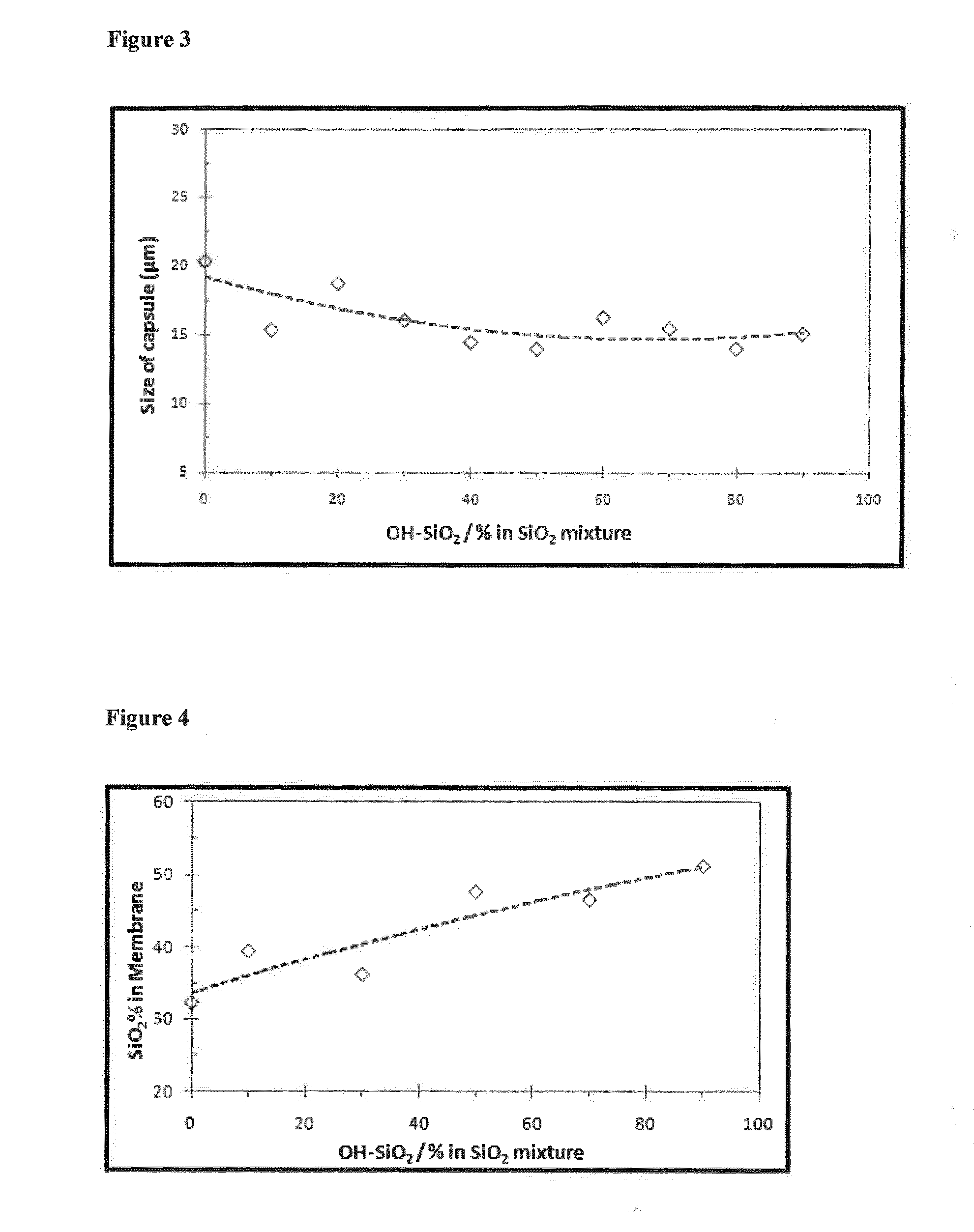Hybrid microcapsules
- Summary
- Abstract
- Description
- Claims
- Application Information
AI Technical Summary
Benefits of technology
Problems solved by technology
Method used
Image
Examples
example 1
Preparation of Hybrid Microcapsules With Mixture of SiO2 Particles
[0070]In the first step, amino-SiO2 particles and hydroxyl-SiO2 particles are dispersed in pH 7 buffer solution using ultrasonic probe. Then the oil phase with crosslinking agent is mixed with aqueous phase. Pickering emulsion is made by using an homogenizer, Ultra Turrax, IKA T25, at 24 000 rpm for 5 min. When stable Pickering emulsion is formed, the pH is adjusted to 9.5 by 5% NaOH aqueous solution. The formulation is described in Table 1 below.
TABLE 1Formulation of hybrid microcapsules preparationIngredientMass / gAmino-SiO2 particles1)0.2625Hydroxyl-SiO2 particles2)0.2625pH 7 buffer3)34.475Desmodur ® N 1004)0.625Takenate ® D-110 N5)0.24Perfume oil6)14.1351)Silicon Oxide particles modified with amino group, origin: SkySpring Nanomaterials, Inc.2)Pyrogenic Silica HDK ® N20, origin: Wacker Chemie AG.3)Di-Sodium hydrogen phosphate and Potassium dihydrogen phosphate buffer solution (pH 7.0)4)Biuret of hexamethylene diiso...
example 2
Comparative Example Between Capsules According to the Invention and Capsules Prepared With One Type of Particles (Amino-SiO2 Particles).
[0073]Measurement Method For Particle Loading on Capsule or in Membrane (Same For All Examples):
[0074]Experiments are carried out on a Thermogravimetric Analyzer (TGA / DSC 1, Mettler-Toledo) equipped with a microbalance having an accuracy of 1 μg.
[0075]The microcapsule slurry is centrifugated 3 times to remove the free dispersed SiO2 particles in water phase, and then microcapsule sample is introduced into an aluminium oxide crucible and the mass change is monitored under controlled temperature with a constant flow of nitrogen of 20 ml / min. The measurement starts at 25° C. and the temperature is increased to 80° C. at a rate of 10° C. / min (keep at 80° C. for 120 minutes), then the temperature is increased to 700° C. at a rate of 10° C. / min (keep at 700° C. for 120 minutes). The particle loading on capsule or in membrane is calculated according to the...
example 3
Preparation of Hybrid Capsules With a Mixture of Amino-SiO2 Particles and Hydroxyapatite Particles (Benchmark Capsules as Described in Example 2)
[0088]In the first step, amino-SiO2 particles and hydroxyapatite particles are dispersed into pH 7 buffer solution using ultrasonic probe. Then the oil phase with crosslinking agent is mixed with aqueous phase. Pickering emulsion is made by using an homogenizer, Ultra Turrax, IKA T25, at 24 000 rpm for 5 min. The formulation is described in Table below.
TABLE 3Formulation of hybrid microcapsules preparationIngredientMass / gAmino-SiO2 particles1)0.42Hydroxyapatitle particles2)0.105pH 7 buffer3)34.475Desmodur ® N 1004)0.625Takenate ® D-110 N5)0.24Perfume oil6)14.1351)Silicon Oxide particles modified with amino group, origin: SkySpring Nanomaterials, Inc.2)Hydroxyapatite particles, origin: Aladdin Chemistry Co. Ltd3)Di-Sodium hydrogen phosphate and Potassium dihydrogen phosphate buffer solution (pH 7.00)4)Biuret of hexamethylene diisocynate, ori...
PUM
| Property | Measurement | Unit |
|---|---|---|
| Fraction | aaaaa | aaaaa |
| Fraction | aaaaa | aaaaa |
| Fraction | aaaaa | aaaaa |
Abstract
Description
Claims
Application Information
 Login to View More
Login to View More - R&D
- Intellectual Property
- Life Sciences
- Materials
- Tech Scout
- Unparalleled Data Quality
- Higher Quality Content
- 60% Fewer Hallucinations
Browse by: Latest US Patents, China's latest patents, Technical Efficacy Thesaurus, Application Domain, Technology Topic, Popular Technical Reports.
© 2025 PatSnap. All rights reserved.Legal|Privacy policy|Modern Slavery Act Transparency Statement|Sitemap|About US| Contact US: help@patsnap.com



